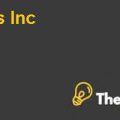Introduction
First Solar manufactures poly voltaic solar systems and cells with an advanced thin film technology and design offer ingit a cost effective competitive edge in the market. Since its inception, the company remained successful and generated high profits, however ,with the passage of time and entry of the new player such as Chinese manufacturers, that produced the same poly voltaic soar system at reduced costand more advanced technology, it creates strong competition in the market, leading to shrunken profits. In addition to this, the rising price of the thin films used in the manufacturing of the solar panels also deteriorates the competitive edge of the company, leading to the immense losses.
First Solar has been formed in 1999, with its commercial launch in 2002.The company dealt in two main segments, namely component segment and system segments. Under the component segments, the company dealt in offering solar modules to the two solar project developers and integrators. On the other hand, the systems segment offered the PV solar panels to the commercial players in the market. Both these segments created strong market share and profit margin under the First Solar portfolio.
Under the market strategy, the company adopted the cost leadership strategy and ascribed the low cost per watt in 2008. In addition to this, the company also attained the fast recycling and payback cyclein the PV industry, it invested the right cash flow amount at the right time, leading to strong market position. First Solar went IPO in 2006, attracting major investors to fund the project in the market and develop a strong business.
First Solar Harvard Case Solution & Analysis
Context
The First Solar is a case that depicts the emergence of innovative technology in the market and its success, which led to the development of acompetitive edge in the market. It also outlines the maintenance of thecompetitive edge in themarket that is difficult to imitate.Infact, it outlines thedependenceof the business purely on the technology anditssustainablecompetitive edge in the market.In addition to this, the particular cases teaches us:
- How to deal with the rising threat of imitation from the externalmarketplayers.
- It suggests the role of globalization on the overall business strategy and the factors that could affect the overall plan of business.
- It also details the rising effect of increased raw material cost on maintenance of the business sustainability in the long term.
- Lastly, it suggests the possible strategies that a business may adopt to overcome the issue raised due to globalization.
Analysis
- Is the solar industry an attractive industry? Why or why not? Be specific. Use Exhibit 9 to calculate ROA, ROIC and Porter’s Five Force Model to respond to the question.
Porte 5 forces Model
Bargaining power of the Buyer
The bargaining power of the buyer is high in themarket. Itis due to the fact thatthere are many players offering similar service in themarket,along with the rise of the globalization effect that has differentiated themarket on the basis of the Watt/cost leading to strong competition and hence,multiple options for the buyers to opt. in the market., however, apart from this, First Solar has strong distribution andmarket strategy in the market. Along with the internal expansion, which is attributed to the instablepolitical systems and regulations.............
This is just a sample partical work. Please place the order on the website to get your own originally done case solution.












